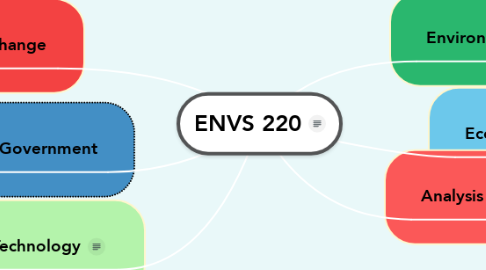
1. Government
1.1. International Policy
1.1.1. Intergovernmental Panel on Policy Change
1.2. United States Policy
1.2.1. Environmental Protection Agency
1.2.2. National Oceanic and Atmospheric Agency
2. Technology
2.1. Renewables
2.1.1. Hydropower
2.1.2. Solar Power
2.1.3. Wind Power
2.1.4. Geothermal
2.2. Energy Storage
2.2.1. Localized Electricity
2.3. Hydrofracking
2.4. Offshore Drilling
3. Climate Change
3.1. Greenhouse Effect
3.2. Albedo
3.2.1. Glaciers
3.3. Extreme Weather
4. Environment
4.1. Contemporary
4.1.1. Urban Ecosystems
4.1.1.1. Buildings
4.1.1.2. Sidewalks
4.1.1.3. Roadways
4.1.1.3.1. Asphalt
4.2. Traditional
4.2.1. Wilderness
4.2.2. Ecosystems
4.2.2.1. Oceans
4.2.2.1.1. Currents
4.2.2.1.2. Tidal Pools
4.2.2.1.3. Photic Zone
4.2.2.2. Forests
4.2.2.2.1. Climax Communities
4.2.2.2.2. Logging
4.2.2.3. Plains
4.2.2.4. Arctic Tundra
4.2.3. Atmosphere
4.2.3.1. Greenhouse Gases
4.2.3.1.1. Carbon Dioxide
4.2.3.1.2. Methane
4.2.3.2. Fossil Fuels
4.2.4. Organisms
4.2.4.1. Producers
4.2.4.2. Consumers
5. Economy
5.1. Global Economy
5.1.1. Fair Trade
5.1.2. Competitive Pricing
5.1.2.1. Mass Production
5.2. National Economy
5.2.1. Wage
5.2.1.1. Minimum Wage
5.2.1.2. Living Wage
5.2.2. Local Products
5.2.3. Capitalism
5.2.3.1. Efficiency
5.2.3.2. Competition
5.2.4. Coorporations
5.2.4.1. Electrical Grid
5.2.4.2. Gas Conglomerates
5.2.4.3. Pharmaceuticals
5.2.4.4. Agriculture
6. Analysis
6.1. Qualitative
6.1.1. Networks
6.1.2. Narrative
6.2. Quantitative
6.2.1. GIS
6.2.2. Statistics
6.2.3. Empirical Data
